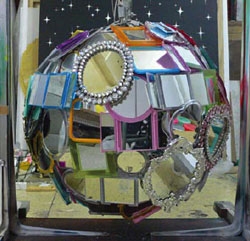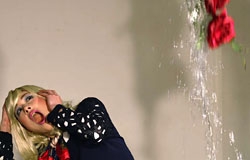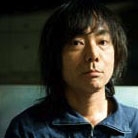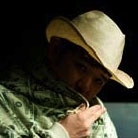Channeling the myriad contradictions of reality into their art
Here are two artists who by their own admission do nothing to stress their Tokyo identity. Even so, the city is indelibly imprinted on their art: perhaps because they search for expressive possibilities in the myriad contradictions of today’s world, in a quest underpinned by real-life experience. Surprisingly, this was the first time they had spoken.
Moderator/text: Uchida Shinichi
Portraits: Nagare Satoshi
 Higashionna Yuichi, untitled (mirror ball 2), 2007
Higashionna Yuichi, untitled (mirror ball 2), 2007 Courtesy Yumiko Chiba Associates
– I believe this is the first such discussion you gentlemen have had, so thank you both for coming along today. Let me start by noting that your work is totally different in style, but if one were to deliberately look for common ground, I’d say it would be the frequent use of optical elements as a technique, as evident at the OP-trance! show (2001) in which you both took part. I also notice that you both seem to choose motifs that are symbolic or allusory in some way or another.
Higashionna For my part I think I’ve always tended to work with ephemera of everyday living not that I like, but rather that I dislike, things equating to what Freud called “the uncanny”. You know, things like those fussy curtains and ribbons, stuff with a whiff of tat; the fancy goods one finds in an ordinary Japanese household. It’s not that I prefer them because they’re pretty, but because I find myself irresistibly drawn to things happy to parade their kitsch, bad-taste status.
Ukawa I know what you mean. Take Hello Kitty: it’s probably a bit late to quote Susan Sontag after all these years, but the reason Kittychan was embraced by Americans too, what’s more adult Americans, was because it was a novelty filtered through the concepts of camp and over-the-top bad taste.
HY For me it’s also important to be familiar with the subject. Optical expression in general clearly has an innate physicality and eroticism. Your work Ukawa-san, in turn tends to be very conceptual, doesn’t it?.
– One intriguing example that comes to mind must be Dr. Toilet’s Rapt-up Clinic. [Editor’s note: An installation consisting of five public toilet cubicles connected by magic mirrors. People entering the cubicles were lulled into a meditative state by a delayed TV sound recording and a synchroenergizer aligning alpha wave induction pulses. This was captured by CCTV camera for others to view as it happened.]
UN But at the same time, to be purely conceptual would be self-limiting. Which is why I also do installations devoid of concept, like the collaboration with EYE, experienced through 5D glasses that act like an effector connecting directly to the eyeballs, and hardcore pieces that involve nothing more complex than raising the viewer’s heart rate. Perhaps that’s how I keep my sanity. However, even if the optical thing is emblematic of both our work, I think it’s good that neither of us relies on it entirely. Dazzling optical illusions generally have minimal internal resonance compared to their physical impact. Which I suspect is why in art history terms, the jury was out for quite a while on op art. So even when I deal in op art, I have this urge to sneak in some psychic waves. Like I want to conjure up Tanba Tetsuro in moire stripes (laughs).
HY I think I’m the type whose sensations become verbalized as I work with my hands. I base my work on the things I’ve just mentioned, but tweaking my ideas in various ways as I go along. Ten years ago I was cynically stressing this “uncanniness”, but I think that vector has now shifted slightly. Take for example the chandelier piece I made from round fluorescent lights. Circular fluorescent lamps are a peculiarly Japanese design, and are also associated in people’s minds with lighting up the homes of Japan through the nation’s recovery after the war. People like Tanizaki Junichiro however, who incidentally were from the era of incandescent lamps, seemed to have disliked this dazzling artificial light intensely, and maintained that in Japan, beauty was found in tranquil gloom, or even darkness. The fact that despite hearing this I produced this over-the-top piece from fluorescent tubes indicates that I too have had a slight change of heart here. It’s as if I’ve started seeking a particular sort of kick out of my work…
UN Lucky you. Lured by the light of fluorescent lamps…?! Some take consistency in style and methodology in an artist’s work to be a virtue…but let’s be honest: our very sense of self shifts slightly with each change over time and in environment, and can never be fixed. Let’s face it, we all have aspects of our early character and ideas we’d be only too eager to deny (laughs).
Exploring ambivalent mixed emotions
– Tell us about the new works you’re about to show at Roppongi Crossing.
HY A new version of the fluorescent light piece I mentioned earlier; a mirror ball made from hand mirrors, and a piece with layers of mesh lace that form different moire patterns depending on the angle of viewing. It occurred to me when I was making the mirror ball that it was impossible to tell what exactly the images reflected in the random mirrors captured, or where I myself would be reflected. That said something to me. And another thing: even though the mirror ball is such an iconic piece of pop kitsch, it seems no one really knows who invented it. Which is quite amazing, and intriguing, don’t you think? Take moire stripes too: familiar enough, but on closer inspection there is indeed something uncanny about them. So I’m presenting these, plus a striped wall made from tape and ribbons, and an installation composed of paintings.
UN Mine is a new piece in a series on natural disasters, allowing visitors to experience a hurricane via a device that recreates the same top speed as Hurricane Katrina that devastated New Orleans, the idea being to “capture a hurricane alive”. I unveiled an earthquake piece back in spring. [This was produced by recreating the 1995 Hanshin Earthquake and 1989 San Francisco quake at an earthquake laboratory in Tsukuba, and making these conditions into an installation. Highresolution video footage shows terrified people with a look of delight flickering across their face for just an instant.] But this hurricane is actually the first chapter in the series. Problems with the size of the thing and the budget delayed its completion, and I’m grateful to the Mori Art Museum for enabling it to be realized for this show. One of my aims in producing this series is to explore our ambivalent mix of emotions regarding disasters: fear, and the flipside: a peculiar sort of exhilaration. I’ve joined the Japan Society for Natural Disaster Science, and am thinking of presenting a paper based on this project.
 Ukawa Naohiro, A Series of Interpreted Catharsis Episode2: Earthquake – San Francisco earthquake / Loma Prieta 1989.10.17 05:04:15-05:04:23pm, 2007
Ukawa Naohiro, A Series of Interpreted Catharsis Episode2: Earthquake – San Francisco earthquake / Loma Prieta 1989.10.17 05:04:15-05:04:23pm, 2007Courtesy Nanzuka Underground, Yamamoto Gendai
HY A theme for today if ever there was one. In a sense, even bigger than land art perhaps? Would I be right in guessing this is a project inspired by some specific personal experience?
UN I’ve experienced three disastrous typhoons in my life so far, the first when I was a child. The disappointment of having all my favorite toys swept away in floodwaters, yet the frisson of capturing our waterlogged home on video; these conflicting emotions have dogged me ever since. This, plus that peculiar ambience that hung about the end of the millennium; while it’s faded, many of us must still share an irresistible desire to “reset” the world, plus that global sense of fin-de-siècle unity. Predictions of Armageddon at the end of the 20th century were a party at which we could all share the same illusion, a party organized by Nostradamus. As a force beyond human understanding, natural disasters are in a different category to war. Moreover the way people feel about disasters is completely different for earthquakes and typhoons/hurricanes, which is in itself very interesting.
Beyond irony and sarcasm
– The obvious existence of so many contradictions in the world is a vital concept for you both, it seems.
UN However the thing is, in art there’s no point confronting your audience with serious subject matter in a serious way all the time, so I like to use various metaphors. Which is why I also like to consider the amusement aspect. When I was doing the earthquake edition of the disaster series, it struck me that things like those earthquake simulation trucks used in emergency evacuation drills are a good example of that. For this show, I’ve been given the only space in the museum with a night view of the city, and in the hurricane simulator there, instead of the usual heavy downpour, people will be assailed by flying paper currency from all over the world. This symbolizes a powerful force resetting each region across national borders, on the other hand with I admit a touch of ironic “money laundering”, this also being Roppongi Hills, a place crawling with the well-off (laughs).
HY Post-modernism has taken the ironic gaze as far as it can go, until now it’s the convention. I’ve pondered how to get over this. But irony being at the very basis of art, I decided it would be impossible to eliminate or overcome easily. Thus the question becomes how to accept this truth but also address it. For this reason also, right now I’m less keen on presenting something in a perverse manner as achieving that kind of kick I mentioned earlier, that humor or erotic sensation.
UN In my case there’s always some kind of critique at the bottom of my work; either that or I’m deliberately thinking of nothing at all. If one considers the question of how we should relate to the environment an important one for our times, as you say inevitably an element of irony creeps in. It can even generate synchronicity. But that’s not all; I personally am seduced by the intensity of art born out of real-life experience. I believe that is where spirits and coincidence will be reflected. Take An Exhibition of Vanishing Objects by Electrical Appliance and Material Safety Law (2006) which I curated [at Nanzuka Underground to raise awareness about the risk of not be able to sell used (classic) electric appliances posed by the new law, in which seven artists participated]. There should be more people from the art side happy to propose that sort of show without any angst. That’s why I keep working as a VJ, and why I run offices with sound systems in the floors. Because in my view, unless its engenders the dynamism of wave movement in the here and now while allowing real people to experience interactive communication on the spot, a work of art is just a thing. One can talk of an art bubble, but all that does is reduce important works to the status of mere stocks and bonds. All the more reason I say, if you possess the means, to come and buy my hurricane with its dancing dosh (laughs).
[This interview appears also in ART iT No. 17 Fall/Winter 2007]

Higashionna Yuichi
Born 1951 in Tokyo. Known since the early 1990s for his works featuring ordinary home furnishings as motifs. Recent solo shows include Flowers (2004, Paris) and Chandelier! (2005, Tokyo); major group shows include Art/Domestic ? Temperature of the Time (1999, Tokyo), Officina Asia (2004, Bologna), and Enjoyable House (2006, Nagoya). He has also created a number of works for retail spaces including Comme des Garcons. His first show of prints was held in Ginza 10.20?11.10.2007.

Ukawa Naohiro
Born 1968 in Kagawa. Self-proclaimed “media rapist”, known for his provocative and critically spirited works utilizing video, graphics, installation, and other media. Lecturer at Kyoto University of Art and Design. Director of the office/club Mixrooffice. Major solo shows include !!!Seed Wars!!! (2003-4, New York), Dr. Toilet’s Rapt-up Clinic (2006, Melbourne) and A Series of Interpreted Catharsis episode2 – earthquake (2007, Tokyo).
